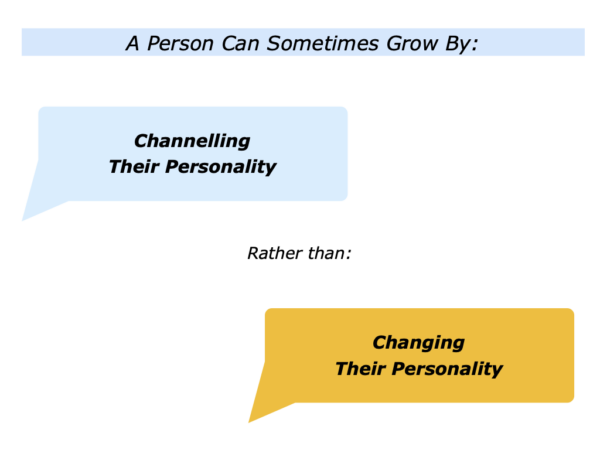
There are many models for helping a person to develop. One approach focuses on helping them to grow by channelling their personality rather than changing their personality.
People develop, they seldom change. Bearing this in mind, it can be useful to help them:
To clarify the real results they want to achieve in a situation – their picture of success;
To clarify their personality style – including both the potential pluses and minuses of their style;
To channel their personality style in ways that help them to achieve their picture of success.
This is an approach I have found useful when working with people who demonstrate certain characteristics. Here is one example.
Max is an energetic and highly driven leader. Being positive and results focused, he can be inspirational and has a track record of building pacesetting teams. He also loves with working with certain kinds of leading edge clients. He helps them to develop strategies that enable them to stay ahead in their field.
The pluses of his style include the following. He generates positive energy and gives people a compelling picture of the future. He is also good at helping certain kinds of clients to solve problems and achieve success.
The potential minuses of his style include the following. He gives lots of ideas and can overload people with information. He only works best with self-motivated achievers and can be impatient with other kinds of people.
Max explained one piece of advice that he had been given.
“I have been told to slow down in order to take my people with me. Whilst I understand part of that logic, I find it difficult to follow.
“My mind keeps focusing on how to solve both the present and future challenges. Plus I get lots of ideas about how to create products that will help our customers to achieve success.
“The problem is that I can sometimes dive into the daily running of our business. If I see something that could be done better, I immediately try to fix it. Maybe I should try to be patient, but I am not sure that will work. Have you any suggestions?”
Max and I looked at how he could channel his personality rather than change his personality. His brain would continue to be in over-drive. Bearing this in mind, it was important for him to spend most of his time with pacesetting customers.
Max could help them to solve challenges and build prototypes that enabled them to achieve future success. This could create wins for them and also wins for his company.
At the same time, I suggested that Max follow the rule of three when sharing ideas with people. This involved him crafting his messages so that, when appropriate, he could aim:
To give the big picture – the context – and to describe the three outcomes to achieve;
To give the reasons for achieving these outcomes;
To check with people whether: a) they understood the outcomes to achieve; b) they would be happy to contribute toward achieving these; c) they had the support required to achieve the outcomes.
Max then moved on to the next stage. How to channel his personality in a way that delivered positive results? After some discussion he chose to take the following steps.
First, Max appointed a managing director who had the ability to run the business. This was somebody who Max had worked with in the past. They had the ability:
To keep focusing on the company’s principles and translate these into action;
To build a positive environment in which motivated people could flourish and deliver good results;
To manage Max’s interventions and integrate his ideas into continuing to build a successful business.
Second, Max applied his strengths to working with certain customers and also aiming to become a thought leader in his chosen field. This involved him taking the following steps. He chose:
To work with three leading edge customers and do superb work that enabled them to stay ahead of the game;
To produce success stories about this work which helped to build their reputations and also that of his own company;
To produce a series of short videos in which Max described pacesetting ideas that companies could implement to achieve future success.
Third, Max continued to share inspiring ideas with the people in his business but he did this through certain channels. He and the managing director ran sessions every two months where they aimed:
To give Max the opportunity to share his latest thinking and, when appropriate, how people could add some of these ideas to their present way of running the business;
To learn from what some of the company’s leading edge customers were doing well and how to adapt these ideas when working with some of their other customers;
To focus on how the company could continue to following its principles, translate these into action and deliver positive results.
Max, the managing director and I continued to work on these themes over the next years. This helped to create an environment in which people applied strengths to help the company to achieve ongoing success.
Every person is different but many can learn how to channel their personalities rather than change their personalities. When working with introverts, for example, it is possible to help them:
To build on their ability to reflect, make sense of ideas and make their best contributions to a client, team or organisation;
To rehearse what they want to do or say and then share their knowledge in ways that increase the likelihood of them getting heard;
To be true to themselves and learn how to take a positive role in situations they find challenging – such as meetings, brainstorming sessions or social events.
There are many ways to help a person to channel their personality. Here are some guidelines that it can be helpful to bear in mind. You will, of course, apply these in your own way.







Leave a Reply